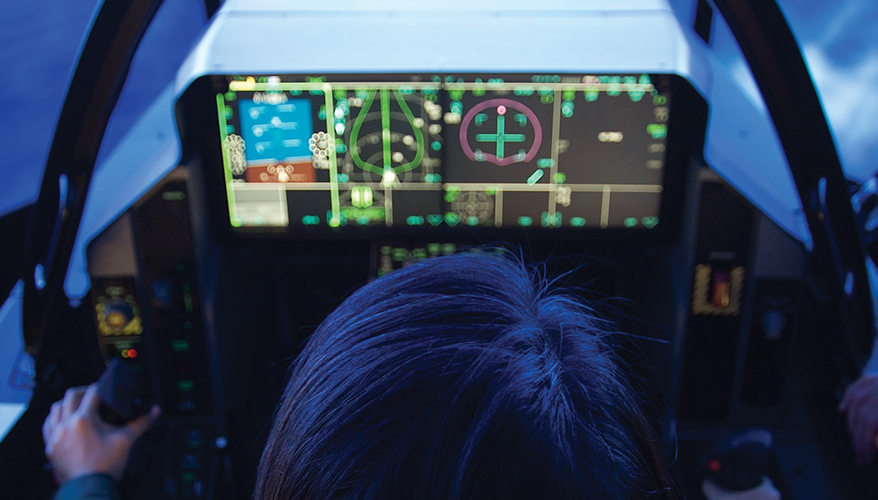AIR FORCE NEWS
Air Force Overhauling Training To Take On Near-Peer Foes
By Stew Magnuson

Air Force photo
ORLANDO — The Air Force is undergoing a top-to-bottom reorganization to transition from counterterrorism operations to competition with more powerful rivals, and its training and simulation systems will be a part of the overhaul.
Secretary of the Air Force Frank Kendall kicked off a campaign last year to address “capability gaps” when it comes to fighting near-peer competitors, Lea Kirkwood, program executive officer for Agile Combat Support, said recently at the Interservice/Industry Training, Simulation and Education Conference in Orlando.
There is a lot of change going on across the Air Force, “and that is no different within the simulators portfolio,” she said.
The service — to start these reforms — is working its way through a series of “cross-cutting operational enablers.” The first of these so-called COEs were electronic warfare, munitions and mobility. Next up is testing and training, which falls under her purview, Kirkwood said.
“When we think about that high-end fight, and we think about how agile our airmen can be, how capable they can be, how can we instill next-gen training is what the secretary is going for,” she said.
Col. Charles Ryan, senior materiel leader for the simulators division at PEO Agile Combat Support, said the Air Force’s main line of effort to overhaul its training and simulation technology is the Simulator Common Architecture Requirements Standards, better known as SCARS.
Most fourth-generation simulators were built as standalone, stove-piped systems, he noted. That was OK when they were developed. “But it’s not how we fight today,” he said.
SCARS will enable the Air Force’s vision of a day when all simulators are interconnected so, for example, a pilot training in a jet fighter simulator can simultaneously connect to pilots training on tanker or bomber simulators, or both.
There are three guiding, main lines of effort to reach the service’s grand vision, he said.
One is developing, fielding and sustaining a common synthetic environment, called the Joint Simulation Environment.
The F-35 Joint Strike Fighter’s simulators, which incorporate the Navy, Air Force and Marine Corps models, inspired the Air Force to duplicate and expand the capability, he said. The Air Force wants to simultaneously simulate missions with F-35s as well as other advanced aircraft such as the F-22 and those in development such as the Next Generation Air Dominance family of systems.
The Joint Simulation Environment concept was rolled out in 2022, but Ryan noted it has been slow to get started.
“It frankly hasn’t made as much progress as I would have liked it [to] at this point,” he said. It took a lot of time to stand up the development team, but now that it is in place, “we’re picking up speed,” he said.
The second line of effort is to increase the capability and interoperability of the distributed training networks that will connect them all together.
And the third will be to ensure sufficient concurrency, fidelity, connectivity and recapitalization of training systems.
“That is what I call the blocking and tackling. That is maintaining currency for our training systems that are in the field today,” he said. There are 14 legacy simulator programs that will have to be maintained, he noted.
Implementing SCARS is the training program’s top priority, Ryan said.
There are two big advantages to creating the interoperable system, he said.
One is “concurrency.” In other words, making sure the latest tactics, techniques and procedures pilots are experiencing in the real world are being quickly and efficiently integrated into simulations.
“This is a gateway to increasing that, which is something we struggle with immensely right now — maintaining concurrency between the jet and the training device,” he said.
The second sea change will be interoperability.
“Most of our training devices from the fourth-gen fleet were built in stovepipes, and they had no intention of having those things work together,” he said.
Another big piece of the new system will be cybersecurity, which also wasn’t built into the legacy systems. Tightening up security by sending out updates and patches to all the simulators through the network will mean less downtime, he added.
Ryan noted there has been some confusion about the differences between SCARS and the Joint Simulation Environment. SCARS will enable the latter, he said. “They’re not in conflict in any way,” he added.
By SCARS version four, the program will be adopting the Government Simulation Interface standards, he said.
But first, SCARS should provide a common hardware that will be applicable to the joint environment.
As for software, a first step will be creating a common geospatial database that can replicate the Earth’s terrain.
While not mentioning the Army’s One World Terrain program by name, Ryan acknowledged that there are similar government databases already in existence, but they may not be a perfect fit.
A foot soldier may “care about a leaf on a tree,” but a pilot flying at 40,000 feet — maybe not so much, he said.
“I’ll just explicitly say the [Joint Simulation Environment] is going to become the cradle to grave common thread for understanding mission effectiveness for the Air Force. And I think the Navy’s on the same track and potentially Space Force in the future as well,” he said. ND
Topics: Training and Simulation
